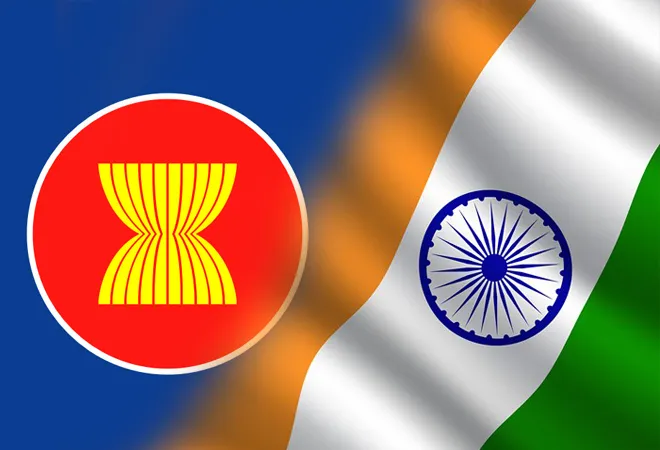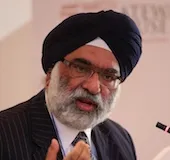
India’s sectoral dialogue partnership started with ASEAN in 1992, soon after India announced its Look East Policy (LEP). The LEP was a consequence of India's economic liberalisation and an economic construct. In 1996, India's partnership was raised to a Dialogue Partnership. In 2002, it was enhanced to the summit level. In 2005, ASEAN was instrumental in bringing India into the East Asia Summit, a major ASEAN-centric institution.
India and ASEAN marked their 20th anniversary with a Strategic Partnership in 2012. The 25th anniversary summit was held in January 2018. That year,
the 10 ASEAN leaders were chief guests at the Republic Day celebrations.
China consolidated its hold over its claims under the nine-dash line over islands and waters of ASEAN countries.
Meanwhile, the LEP was converted to the Act East Policy (AEP) in 2014. It sought to deepen and diversify the economic and related cooperation. It increased cooperation in different spheres. In 2015,
ASEAN created three communities under which it organised its development and relations with its partners. These were the Political-Security Community, the Economic Community, and the Socio-Cultural Community.
India, ASEAN and the emergence of the Indo-Pacific
Traditionally, India's relationship was on the economic side; the socio-cultural aspect moved ahead purposefully through functional cooperation. It was perceived that the political-security pillar of the relationship required attention. This included traditional and non-traditional security challenges including HADR (humanitarian assistance and disaster relief), security cooperation, and freedom of navigation as the key areas for maritime cooperation.
These were discussed at the Delhi Dialogue X in July 2018. This was a month after PM Modi articulated
India’s Indo-Pacific policy at the Shangri-La Dialogue.
ASEAN was apprehensive about its relationship with China, particularly in the South China Sea. There was little progress on the code of conduct, under negotiation since 2002. China consolidated its hold over its claims under the nine-dash line over islands and waters of ASEAN countries. In the face of this, India-ASEAN maritime cooperation was really a function of how much anxiety ASEAN would bear from China. By 2018, their apprehension of dealing with India based on what China would think was overcome.
Meanwhile, the Indo-Pacific concept had come to the fore. PM Modi enunciated
India’s policy at the Shangri-La dialogue in 2018. Japan, Australia, and the US announced their policies too. In 2019, despite Chinese aversion, ASEAN announced an
ASEAN Outlook on the Indo- Pacific (AOIP).
Partnerships amongst willing countries to enhance maritime security, sustainability of marine resources, and disaster prevention and management were sought.
This was a significant landmark.
At the 14th East Asia Summit (EAS) in Bangkok, in November 2019, India announced its Indo Pacific Oceans Initiative (IPOI), emphasising the need to work together to seek common solutions while following a rule-based international order. The IPOI sought a safe, secure, and stable maritime domain in the region. Partnerships amongst willing countries to enhance maritime security, sustainability of marine resources, and disaster prevention and management were sought. IPOI synchronised with priority areas in AOIP, and the
EAS statement for a Partnership on Sustainability,
At the 18th ASEAN-India Summit on 28 October 2021, the ASEAN-India Joint Statement on Cooperation on the AOIP for Peace, Stability, and Prosperity in the Region was enunciated.
ASEAN-India Joint Statement on Cooperation on the AOIP
The Indo-Pacific concept is a strategic one; the AOIP and joint statement are functional. They are about peace and stability, but focus on prosperity. There is a commitment to support the ASEAN community building using development cooperation; it mentions grasping opportunities from current and future regional and global events. The exploration of cooperation between the AOIP and the IPOI include
the four priority areas of the AoIP, which are maritime cooperation, connectivity, the SDGs (sustainable development goals), and economic and related cooperation. The SDGs and the non-strategic maritime cooperation are within the domain of socio-cultural cooperation while the connectivity and economic aspects are cross-cutting.
Of the 21 specific activities mentioned under paragraph 4 of the Statement, there is only one is security related: 4.21 refers to ‘maritime security, efforts to counter piracy and armed robbery against ships, maritime safety and search and rescue (SAR) operations’ The 20 other points are all functional, like narrowing the development gaps and capacity-building development of social infrastructure including public health vaccines and pharmaceutical research and cooperation amongst universities rather than research agencies in the health sector.
The exploration of cooperation between the AOIP and the IPOI include the four priority areas of the AoIP, which are maritime cooperation, connectivity, the SDGs (sustainable development goals), and economic and related cooperation.
Human capital development through technical and vocational education; People to People connectivity through education, women empowerment, youth, tourism media, think tanks and local governments are all key priority areas. Science, Technology, smart and green infrastructure, sustainable cities and engaging with the ASEAN Smart Cities Network emerge from this cooperative document. Renewable energy, reducing carbon imprint, bio-circular green development, environment protection, waste management, marine debris management and the like are also clear-cut areas of collaboration mentioned.
Collaboration on maritime Education Research, Development, Innovation and pilot projects are introduced through this mechanism. Support for the ASEAN Centre for biodiversity through regional capacity building and climate change adaptation and mitigation measures as well as Disaster Risk Reduction and Management including through cooperation with relevant ASEAN centres all find clear cut mention.
The statement is intended as a strategic one; in reality, it is functional, focusing on aspects of the socio-cultural cooperation even more than in economic cooperation. Most of these are covered under the
India ASEAN Plan Of Action 2021-2025. Since no financing mechanism is mentioned in the document, the POA funds will be utilised.
The enunciation of the AOIP was important from the point of view of ASEAN because it took the ASEAN-centric Asia Pacific concept to a wider concept across the Indo-Pacific. ASEAN placed itself within the new strategic construct of the Indo-Pacific, but hedged it with immense functionality. In fact, ASEAN while talking about it's a AOIP in June 2019 emphasised that the Asia-Pacific and the Indian Ocean regions were economically dynamic and experiencing geopolitical and geostrategic shifts. The AOIP grasps at opportunities since mostly the challenges were beyond the realm of ASEAN to deal with.
Linkages with the Indo-Pacific Oceans Initiative
ASEAN’s intent was to prevent a lack of trust leading to miscalculations and to induce Confidence Building Measures while at the same time working to improve the life of the people in the region.
The Indo-Pacific Oceans Initiative (IPOI) relooks at the Indo-Pacific to create a functionality and confidence building for a rule-based maritime order. The IPOI supports an open inclusive, resilient, prosperous Indo-Pacific; it seeks to build practical cooperation including with Quad partners like Australia, Japan and the US besides with ASEAN.
ASEAN while talking about it's a AOIP in June 2019 emphasised that the Asia-Pacific and the Indian Ocean regions were economically dynamic and experiencing geopolitical and geostrategic shifts.
Under IPOI, bilateral goals with various partners are lured into specific areas of cooperation within the defined pillars.
For instance, the Australia India Joint Declaration on a shared vision for maritime cooperation in the Indo Pacific, which is a part of the Australia India comprehensive strategic partnership of June 2020 augments IPOI. The IPOI is aligned with bilateral arrangements and extends to cooperation that both Australia and India have with ASEAN under the AOIP.
These commonalities are also very well captured in the ASEAN-India Joint Statement on cooperation on AOIP, which now acts as a beacon to guide our engagement in the region.
In fact, the enunciation of the AoIP at the EAS in November 2019 followed the AOIP and sought deeper engagement between India and its partners in the region to safeguard the oceans, enhance maritime security, preserve marine resources, and capacity building. HADR, R&D, academic cooperation, and mutually beneficial trade and the like, were all important.
The IPOI has seven pillars. Capacity Building and Resource Sharing; Disaster Risk Reduction and Management; Maritime Ecology; Maritime Resources; Maritime Security; Science, Technology and Academic Cooperation; and Trade Connectivity and Maritime Transport.
To cooperate on the pillars of the IPOI
, India identified partners for each of the IPOI pillars to generate ideas and develop studies. These include NCCR/INCOIS for Marine Ecology, NMF and ICWA for Marine Security, FSI, Mumbai and NIOT Chennai for Marine Resources, NIO Goa, INCOIS Hyderabad, ICWA for Capacity Building and Resources Sharing, NDMA for Disaster Risk Reduction and Management, FSI, Mumbai, IOM, Chennai, NIO Goa, and InCOIS Hyderabad for Science, Technology and Cooperation, RIS for Trade, connectivity and Transport.
The IPOI is aligned with bilateral arrangements and extends to cooperation that both Australia and India have with ASEAN under the AOIP.
These pillars are not directly mentioned but are all covered among the 21 paragraphs that are written from the ASEAN point of view. What IPOI seeks are individual countries to join selected pillars. India is the lead in the Disaster Risk Reduction and Maritime Security pillar of the IPOI.
Australia is the lead partner on the maritime ecology pillar. In 2020, Japan agreed to lead the connectivity pillar. France and Indonesia lead the Maritime Resource Pillar. Singapore is in the academic and S&T pillar. The partners also place seed funding into their activities and this should see expansion in the future.
IPOI is a wider partnership to nurture cooperation, and it will link with existing regional mechanisms and arrangements, including those with ASEAN through AOIP, the IORA (Indian Ocean Rim Association) and the Pacific Islands Forum, besides BIMSTEC (The Bay of Bengal Initiative for Multi-Sectoral Technical and Economic Cooperation). It requires an ASEAN+ approach. ASEAN and India agree on AOIP-IPOI cooperation. India will implement some of the AOIP objectives as part of its ASEAN partnership. For IPOI, Indian partners could link with individual ASEAN members. Singapore and Indonesia are a good start and
Vietnam, Thailand.
Philippines and
Malaysia are candidates once their approach to the Indo-Pacific matures.
The views expressed above belong to the author(s). ORF research and analyses now available on Telegram! Click here to access our curated content — blogs, longforms and interviews.



 India’s sectoral dialogue partnership started with ASEAN in 1992, soon after India announced its Look East Policy (LEP). The LEP was a consequence of India's economic liberalisation and an economic construct. In 1996, India's partnership was raised to a Dialogue Partnership. In 2002, it was enhanced to the summit level. In 2005, ASEAN was instrumental in bringing India into the East Asia Summit, a major ASEAN-centric institution.
India and ASEAN marked their 20th anniversary with a Strategic Partnership in 2012. The 25th anniversary summit was held in January 2018. That year,
India’s sectoral dialogue partnership started with ASEAN in 1992, soon after India announced its Look East Policy (LEP). The LEP was a consequence of India's economic liberalisation and an economic construct. In 1996, India's partnership was raised to a Dialogue Partnership. In 2002, it was enhanced to the summit level. In 2005, ASEAN was instrumental in bringing India into the East Asia Summit, a major ASEAN-centric institution.
India and ASEAN marked their 20th anniversary with a Strategic Partnership in 2012. The 25th anniversary summit was held in January 2018. That year,  PREV
PREV


